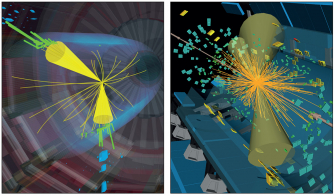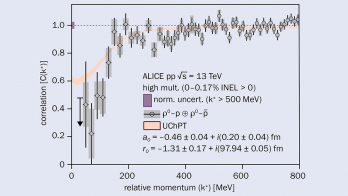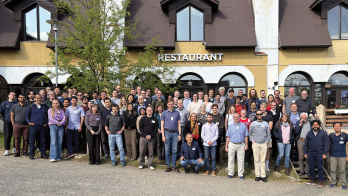
It has long been known that, when they are put under a sufficiently energetic microscope, nuclei reveal a complicated structure – the more energetic the probe, the more complex the structure. In recent years, continuing studies of deuteron–nucleus (dA) and proton–nucleus (pA) collisions have demonstrated that many features first observed in heavy-ion (AA) collisions are also present in these lighter collisions, and some of these features have even been seen in high-multiplicity pp collisions. Such factors have generated the present intense interest in nuclear structure that was evident when more than 120 physicists gathered in California’s Napa Valley on 3–7 December, to discuss the initial state in these collisions during the 2nd International Conference on Initial Stages in High-Energy Nuclear Collisions (IS2014).
In particular, pA collisions at the LHC have demonstrated the existence of anisotropic particle production. The angular distributions look very similar to those observed in AA collisions, where the anisotropy has been attributed to hydrodynamic flow. The material produced in these collisions appears to flow like a low-viscosity fluid, and the final-state anisotropy mimics that present in the initial elliptic-shaped collision region. Recent studies at Brookhaven’s Relativisitic Heavy-Ion Collider (RHIC) as well as at the LHC have shown that, in addition to the American-football-shaped collision region, there are also event-to-event anisotropies caused by the different random positions of nucleons within the nucleus. Much of the observed anisotropy might be explained by models based on hydrodynamic flow. One focus of IS2014 was the question of how hydrodynamic flow can arise in smaller nuclear systems, particularly pA collisions. One new approach to this question is being pursued at RHIC, in which 3He collided with gold last year, to see how the triangular initial state manifests itself in the collision products (figure 2).

(Image credit: J L Nagle et al. 2014 Phys. Rev. Lett. 113 112301.
Some of these phenomena also appear in high-multiplicity pp collisions. One example is “the ridge” observed as two-particle correlations between particles with similar azimuthal angles, but separated by large rapidities. In contrast, one other expected consequence of the quark–gluon plasma – jet quenching – appears to be present only in AA collisions, for the most part.
The meeting also covered recent theoretical developments. As the centre-of-mass energies increase, collisions probe partons with smaller and smaller momentum fractions (Bjorken-x values). And as the x-values decrease, the parton density increases, and at low enough x values, saturation must set in. This happens when gluons begin to recombine as well as to split. Although saturation is expected on general principles, the details remain the subject of spirited theoretical discussion. One key question addressed in Napa was the search for the colour-glass condensate (CGC), a hypothetical state of matter where the gluons produce coherent fields. These CGCs lead to new nuclear phenomena.
The meeting included presentations on a variety of experimental techniques. The RHIC and LHC collaborations all made presentations highlighting their data and plans for AA, pA and pp collisions. In addition to hadronic collisions, one session was devoted to ultra-peripheral collisions, where two colliding nuclei interact electromagnetically. Here, reactions such as photonuclear production of vector mesons are sensitive to details of the nuclear initial state.
The congenial atmosphere led to many fruitful discussions, and a third conference is planned in Lisbon in 2016.
• For more about IS2014, visit http://is2014.lbl.gov.








